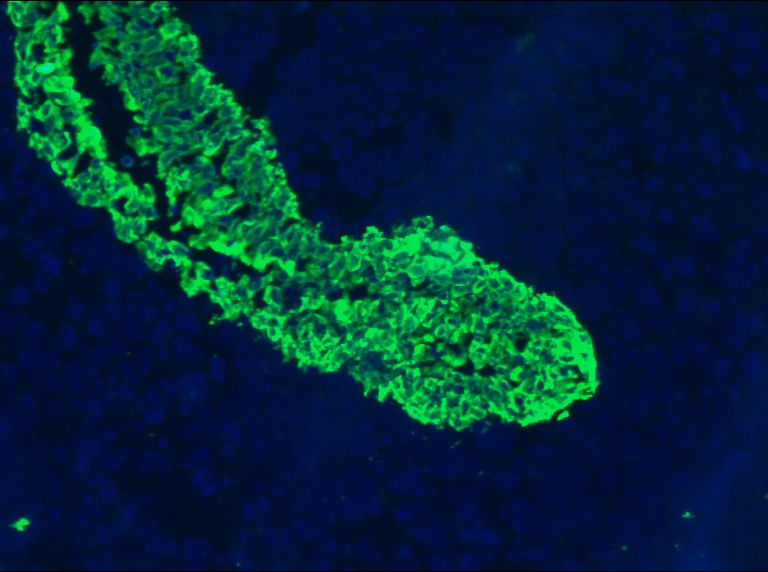Catalogue

Mouse anti Cytokeratin 5 + 8 / Keratin K5 + K8
Catalog number: MUB0314P-CE/IVD| Clone | RCK102 |
| Isotype | IgG1 |
| Product Type |
Primary Antibodies |
| Units | 0.1 mg |
| Host | Mouse |
| Species Reactivity |
Canine Feline Hamster Human Mouse Rabbit Rat Swine |
| Application |
Flow Cytometry Immunocytochemistry Immunohistochemistry (frozen) Immunohistochemistry (paraffin) Western Blotting |
Background
Cytokeratins are a subfamily of intermediate filament proteins and are characterized by a remarkable biochemical diversity, represented in Human epithelial tissues by at least 20 different polypeptides. They range in molecular weight between 40 kDa and 68 kDa and isoelectric pH between 4.9 – 7.8. The individual Human Cytokeratins are numbered 1 to 20. The various epithelia in the Human body usually express Cytokeratins which are not only characteristic of the type of epithelium, but also related to the degree of matuRation or differentiation within an epithelium. Cytokeratin subtype expression patterns are used to an increasing extent in the distinction of different types of epithelial malignancies. The Cytokeratin antibodies are not only of assistance in the differential diagnosis of tumors using immunohistochemistry on tissue sections, but are also a useful tool in cytopathology and flow cytometric assays.
Source
RCK102 is a Mouse monoclonal IgG1 antibody derived by fusion of SP2/0 Mouse myeloma cells with spleen cells from a Mouse immunized with Cytokeratins from a Human lung cancer cell line (MR21).
Product
Each vial contains 100 ul 1 mg/ml purified monoclonal antibody in PBS containing 0.09% sodium azide.
Formulation: Each vial contains 100 ul 1 mg/ml purified monoclonal antibody in PBS containing 0.09% sodium azide.
Specificity
RCK102 is a Cytokeratin antibody reacting with Cytokeratin 5 and Cytokeratin 8. This monoclonal antibody recognizes virtually all epithelial tissues and carcinomas.
Applications
RCK102 is suitable for immunoblotting, immunocytochemistry, immunohistochemistry on frozen sections and paraffin-embedded tissues and flow cytometry. Optimal antibody dilution should be determined by titration; recommended range is 1:100 – 1:200 for flow cytometry, and for immunohistochemistry with avidin-biotinylated Horseradish peroxidase complex (ABC) as detection reagent, and 1:100 – 1:1000 for immunoblotting applications.
Storage
The antibody is shipped at ambient temperature and may be stored at +4°C. For prolonged storage prepare appropriate aliquots and store at or below -20°C. Prior to use, an aliquot is thawed slowly in the dark at ambient temperature, spun down again and used to prepare working dilutions by adding sterile phosphate buffered saline (PBS, pH 7.2). Repeated thawing and freezing should be avoided. Working dilutions should be stored at +4°C, not refrozen, and preferably used the same day. If a slight precipitation occurs upon storage, this should be removed by centrifugation. It will not affect the performance or the concentration of the product.
Caution
When used for in vitro diagnostic purposes results must be put within the context of other diagnostic tests as well as the clinical history of the patient by a certified professional before final interpretation. Analyses performed with this antibody should be paralleled by positive and negative controls. If unexpected results are obtained which cannot be attributed to differences in laboratory procedures, please contact us. This product may contain hazardous ingredients. Please refer to the Safety Data Sheets (SDS) for additional information and proper handling procedures. Dispose product remainders according to local regulations.This datasheet is as accurate as reasonably achievable, but Nordic-MUbio accepts no liability for any inaccuracies or omissions in this information.
References
1. Broers, J. L., Carney, D. N., Klein Rot, M., Schaart, G., Lane, E. B., Vooijs, G. P., and Ramaekers, F. C. (1986). Intermediate filament proteins in classic and variant types of small cell lung carcinoma cell lines: a biochemical and immunochemical analysis using a panel of monoclonal and polyclonal antibodies, J Cell Sci 83, 37-60.
2. Smedts, F., Ramaekers, F., Robben, H., Pruszczynski, M., van Muijen, G., Lane, B., Leigh, I., and Vooijs, P. (1990). Changing patterns of Keratin expression during progression of cervical intraepithelial neoplasia, Am J Pathol 136, 657-68.
3. Ramaekers, F., Huysmans, A., Schaart, G., Moesker, O., and Vooijs, P. (1987). Tissue distribution of Keratin 7 as monitored by a monoclonal antibody, Exp Cell Res 170, 235-49.
4. Smedts, F., Ramaekers, F., Troyanovsky, S., Pruszczynski, M., Link, M., Lane, B., Leigh, I., Schijf, C., and Vooijs, P. (1992). Keratin expression in cervical cancer, Am J Pathol 141, 497-511.
5. Raats, J. M., Pieper, F. R., Vree Egberts, W. T., Verrijp, K. N., Ramaekers, F. C., and Bloemendal, H. (1990). Assembly of amino-terminally deleted desmin in vimentin-free cells, J Cell Biol 111, 1971-85.
6. Ramaekers, F., van Niekerk, C., Poels, L., Schaafsma, E., Huijsmans, A., Robben, H., Schaart, G., and Vooijs, P. (1990). Use of monoclonal antibodies to Keratin 7 in the differential diagnosis of adenocarcinomas, Am J Pathol 136, 641-55.
7. Bauwens, L. J., De Groot, J. C., Ramaekers, F. C., Veldman, J. E., and Huizing, E. H. (1992). Expression of intermediate filament proteins in the adult Human vestibular labyrinth, Ann Otol Rhinol Laryngol 101, 479-86.
8. Schaafsma, H. E., Ramaekers, F. C., van Muijen, G. N., Lane, E. B., Leigh, I. M., Robben, H., Huijsmans, A., Ooms, E. C., and Ruiter, D. J. (1990). Distribution of Cytokeratin polypeptides in Human transitional cell carcinomas, with special emphasis on changing expression patterns during tumor progression, Am J Pathol 136, 329-43.
9. Coonen E., Dumoulin J.C.M., Ramaekers F. (1993). Intermediate filament protein expression in early developmental stages of the Mouse, Histochem 99, 141-149
CE Mark
CE
Protein Reference(s)
Database Name: UniProt
Accession Number: P05787 & P13647
Safety Datasheet(s) for this product:
| NM_Sodium Azide |

Figure 1. Indirect immunofluorescence staining of a frozen section of human urinary bladder using MUB0314P (clone RCK102) at a 1:200x dilution. Note strong staining of urothelium and no reactivity in the connective tissue or muscle tissue.

